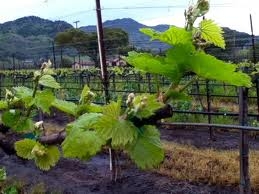
 It is about that time of year when any of us who have a small home vineyard or acres of vineyards anticipate bud break. By now we have all done our pruning on the dormant vines and are waiting for the first signs of a new vintage.
It is about that time of year when any of us who have a small home vineyard or acres of vineyards anticipate bud break. By now we have all done our pruning on the dormant vines and are waiting for the first signs of a new vintage.
But we are also aware that with bud break come all the other concerns in managing our vines: frost protection, rain at the wrong time and powdery mildew. And more powdery mildew. The last few years have taught us to be flexible and not anticipate what nature has in store.
Managing the vineyard is less stressful if we know we have done all we can to improve the chances of a successful fall harvest. Powdery mildew is the most serious and widespread disease in California vineyards in terms of cost of control and losses in yield. Wine quality can be affected when as few as 3 percent of the berries are diseased; severe mildew may cause berries to crack, allowing rot-promoting organisms to enter. Surprisingly, powdery mildew is not the same mildew we get on roses.
All succulent tissues on a grapevine are susceptible to mildew, and the fungus begins to show shortly after bud break. Usually within one week of the first spring rain you can see colonies on the underside of leaves. The fungus forms a white, web-like mat over the leaf tissue and draws nutrients from the plant tissue. This leaves develop a dusty appearance as the spores spread.
How does mildew get started? It cannot grow on dead or dormant grape tissue. It survives the winter under infected buds; or when autumn rains wash the spores off of leaves and shoots and onto the bark of upper trunks and cordons. In the spring, rain and sprinklers release the spores and wind blows them onto newly emerging shoots and leaves. If you had a lot of mildew the previous year, you might see red, stain-like scarring on vine canes. This is dormant mildew. Buds near this scarring will start to be infected.
In mild weather, spores germinate in less than five days. Mildew really loves temperatures between 70°F and 85°F. High temperatures kill the spores. And temperatures above 95°F for 12 continuous hours cause the mildew to stop growing. Temperature plays a larger role in the disease development than moisture and humanity. Rain, dew and irrigation water can actually cause poor germination of the mildew spores, and they can sometimes even be washed away. Powdery mildew is spread by windborne spores and they can travel a long distance.
The infection in the fruit can continue until certain sugar levels are reached in the grapes. The damage can cause stunted berries, decreased yield, delayed ripening, scarring and off flavors in the wine. Some varieties are more susceptible to mildew, including Chardonnay, Cabernet Sauvignon, Carignane and table grapes.
To control powdery mildew, it is best to apply preventatives and keep applying them. It is difficult to eradicate and you need to start early. Many materials can be used. For advice, visit www.ipm.ucdavis.edu/PMG/crops-agriculture.html.
Protect vines and new buds and leaves before your vines become infected. Fungicides will inhibit spore development and germination. Sulfur is an effective and economical control and in most years provides adequate protection. Other options are also available.
New vines do not need treatment, but in the second year, you should monitor for mildew on leaves. After year two, start the regimen.
To summarize, if you grow grapevines, you will have to treat for mildew every year. The control is a preventative. Some products provide longer protection than others. Be sure to watch the weather.
Workshop: On Saturday, April 6, from 9:30 a.m. to noon, Napa County Master Gardeners will present a workshop on “Small Home Vineyards” at the Yountville Community Center. The fee is $15. Call 707-944-8712 to register or register online at www.townofyountville.com/index.aspx?page=274. Call the Master Gardener office for more information at 707-253-4221.
Master Gardeners are volunteers who help the University of California reach the gardening public with home gardening information. Napa County Master Gardeners (http://cenapa.ucdavis.edu) are available to answer gardening questions in person or by phone, Monday, Wednesday and Friday, 9 a.m. to Noon, at the U. C. Cooperative Extension office, 1710 Soscol Avenue, Suite 4, Napa, 707-253-4143, or from outside City of Napa toll-free at 877-279-3065. Or e-mail your garden questions by following the guidelines on our web site. Click on Napa, then on Have Garden Questions?